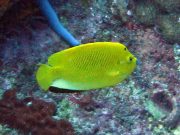Tauchen mit Kaiserfische
Meeresleben von Lanta | Pomacanthidae
Die 96 Arten von Kaiserfischen gehören zu den farbenprächtigsten und auffälligsten Fischen, die in Korallenriffen zu finden sind. Mehrere Arten sind regelmäßig bei Tauchausflügen vor Koh Lanta anzutreffen.
Diese Familie umfasst längliche oder ovale, tiefgestaltete und stark zusammengedrückte Fische, die außerdem kurze Schnauzen, kleine Mäuler und borstenartige Zähne haben.
Diese Familie hat abgerundete Schwänze und eine durchgehende Rückenflosse, wobei Kopf und Körper mit groben Schuppen bedeckt sind.
Kaiserfische ähneln stark den Falterfischen und fast alle Arten sind sehr farbenprächtig mit komplexen und vielfältigen Farbmusterungen. Ein sehr deutlicher Unterschied zwischen Falterfischen und Kaiserfischen besteht darin, dass alle Kaiserfischarten einen markanten und kräftigen Stachel an der Unterseite der Kiemendeckel haben.
Die meisten Arten ernähren sich von Schwämmen und anderen wirbellosen Meerestieren, einige ernähren sich von Plankton.
5 Arten auf dieser Seite gefunden:
Blue Ring Angelfish
(Pomacanthus annularis)
The Blue Ring Angelfish is one of the larger angelfishes, reaching up to 45 cm in length. This species has a golden brown to orangish body with many upward curving blue bands. The tail is white, with a yellow margin and there is a blue ring above the pectoral fin. There are numerous blue markings on the head.

Pomacanthus annularis @ Koh Phi Phi
The Blue Ring Angelfish is sometimes seen alone, but often in pairs. The diet of this species includes sponges, sea squirts and zooplankton.
Juvenile Blue Ring Angelfish have a bluish to black under colour, with narrow, closely spaced pale blue and white bars which are slightly arched, or bowed toward the head. Two or three of these bars are usually wider and more intensely coloured than the rest. The tail fin is white or translucent.
Emperor Angelfish
(Pomacanthus imperator)

Pomacanthus imperator @ Koh Bida
The emperor angelfish is very easy to identify from its bright blue and yellow stripes and yellow tail. This species has a black mask with blue margin across the eyes, and a broad black bar behind the head, again with a blue margin.
The emperor angelfish grows to 38 cm and can be solitary, but often seen in pairs along reef edges. Their diet includes sponges, tunicates (e.g. sea-squirts and other invertebrate filter feeders), and other encrusting organisms.
Juvenile emperor angelfish are dark blue with electric blue and white rings, and a white margin on the dorsal fin.
Blacktail Angelfish
(Centropyge eibli)

Centropyge eibli @ Koh Haa
The blacktail angelfish is one of the larger of the dwarf angelfishes, reaching up to 15 cm in length.
This fish is pale grey with thin brownish / reddish / orange stripes, a black tail and tail base. Both the rear end of the dorsal fin and the tail fin have a sapphire-blue margin.
This species is usually solitary, but may occasionally be seen in pairs. The diet includes soft corals and algae.
Indian Yellowtail Angelfish
(Apolemichthys xanthurus)

Apolemichthys xanthurus @ Koh Haa
The Indian Yellowtail Angelfish has a whitish to cream body colour and a dark margin around the entire body. The face is dark and the body scales have dark tips which gives a spotted effect.
The rear dorsal and anal fins are black with a white margin and the tail fin is yellow.
This species can occasionally be found with the Indian Vagabond Butterflyfish which has a similar appearance.
The Indian Yellowtail Angelfish is a medium sized angelfish, growing to around 15 cm, but more often observed around 10 cm - 12 cm.
This is a shy species, found in pairs and rarely seen at the dive sites around Koh Lanta.
Three-Spot Angelfish
(Apolemichthys trimaculatus)

Apolemichthys trimaculatus @ Hin Muang
The Three-Spot Angelfish has a bright yellow body with a dark spot on the forehead and one each side close to the the gills, at eye-level. The mouth and lips are a vivid blue colour.
There is a grey patch between the eyes and the preopercle spine (spine jutting out below the gills) is light bluish grey.
All the fins are yellow, except for the anal fin which is white with a large black margin.
The Three-Spot Angelfish grows to 26 cm, but more likely observed around 10 cm - 15 cm. The diet includes sponges and tunicates such as sea squirts. Rarely seen at the dive sites around Koh Lanta.
Tauchen mit Kaiserfische rund um Koh Lanta
Tauch- und Schnorchelausflüge
Wenn Sie gerne die Gelegenheit hätten, Kaiserfische auf einem unserer täglichen Tauchausflüge während der Hochsaison von Koh Lanta aus zu sehen, dann senden Sie uns eine E-Mail an info@diveandrelax.com.
Nehmen Sie an unseren Speedboot-Tauchausflügen in der Hochsaison zu einigen der besten Tauchplätze Thailands teil und genießen Sie kleine Gruppen, kurze Fahrzeiten und einen Fokus auf hervorragenden persönlichen Service, Sicherheit und Spaß.
Noch kein zertifizierter Taucher? Lernen Sie auf Koh Lanta das Tauchen mit dem 3-tägigen SSI Open Water Diver Kurs.
Buchen Sie online und sparen Sie 10% auf Tauchausflüge und Tauchkurse auf Koh Lanta.
Weitere Informationen
Indo-Pazifische Meereslebewesen-Führer
- Allen, G., Steene, R., Humann, P., DeLoach, N. (2003) Reef Fish Identification, Tropical Pacific. Jacksonville, FL., USA: New World Publications, Inc., ISBN 1-878348-36-1.
- Humann, P., DeLoach, N., (2010) Reef Creature Identification, Tropical Pacific. Jacksonville, FL., USA: New World Publications Inc., ISBN 978-1-878348-44-9
- Debelius, H. (2013) Indian Ocean Reef Guide. Frankfurt, Germany: IKAN - Unterwasserarchiv, ISBN 978-3-939767-52-7.
- Debelius, H. (2004) Nudibranchs and Sea Snails, Indo-Pacific Field Guide. Frankfurt, Germany: IKAN - Unterwasserarchiv, ISBN 3-925919-51-1
- Erhardt, H., Knop, D. (2015) Corals Indo-Pacific Field Guide. Frankfurt, Germany: IKAN - Unterwasserarchiv, ISBN 3-925919-69-4.
- Veron J.E.N., Stafford-Smith M.G., Turak E. and DeVantier L.M. (2016). Corals of the World
Weitere Referenzen zu Meereslebewesen und weitere Informationen


